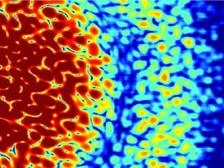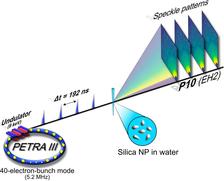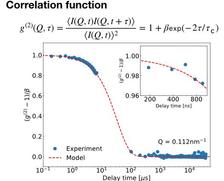Fig. 1: Simulated speckle pattern in a small angle X-ray scattering (SAXS) regime (Credit: DESY).
A research team from DESY has demonstrated for the first time the feasibility of employing intrinsic pulse structure of PETRA III to conventional X-ray Photon Correlation Spectroscopy to achieve nanosecond time resolution in studying dynamical processes of nanoscopic systems. They recorded the fastest correlation times with this technique at storage rings so far by investigating dynamics of colloidal silica particles in small angle X-ray scattering configuration, using an ‘Adaptive Gain Integrating Pixel’ detector. The findings were published in the journal ‘International Union of Crystallography’.
X-ray Photon Correlation Spectroscopy (XPCS) is a very powerful and well-established technique to study dynamics of various complex disordered systems at 3rd generation storage ring sources on time scales from sub-milliseconds to seconds. The time resolution in such experiments has up to now been defined by the frame rate of 2D detectors. Recent development of ultrafast detectors opened up the possibility to push the time resolution limit to nanoseconds, restricted only by the frequency rate of a storage ring. However, a very important challenge still remains: is the coherent flux from a single X-ray pulse sufficient to study ultrafast dynamics?
The experiment has been carried out at the coherence beamline P10 at PETRA III using the 40-bunch mode for timing experiments. The sample, colloidal silica particles dispersed in water, was illuminated coherently by the pulsed X-ray beam. The grainy interference patterns, so-called speckles, were collected at the detection plane. Each resulting speckle pattern (Fig. 1) is related to the spatial arrangements of the colloidal particles. When the particles move during the collection of each single speckle image, the corresponding speckle pattern will change accordingly. The dynamics of the sample were traced by measuring temporal intensity fluctuations in the speckle patterns by calculating an autocorrelation function in time-domain (Fig. 2). As a final result, the correlation functions obtained from speckle patterns of freely diffusing silica particles in water, showed the expected dynamics within a nano- to millisecond time range (Fig. 3).
Essential for this work was the availability of Adaptive Gain Integrating Pixel Detector (AGIPD), developed by a collaboration including DESY. Originally designed for European XFEL, AGIPD is a novel detector system providing very high dynamical ranges and storing the recorded patterns into 352 analogue memory cells per pixel. In this work, the frame rate of the detector was adapted to the frequency of the PETRA III storage ring, i.e., 5.2 MHz. This allowed recording speckle patterns of individual synchrotron X-ray pulses every 192 ns. Faster dynamics, i.e., beyond the X-ray bunch spacing limit, can be accessed with split-pulse techniques.
Successful demonstration of this technique is especially valuable and timely in the context of the planned PETRA IV project, the upgrade of the PETRA III light source which will deliver much higher coherent photon flux. PETRA IV will extend the range for studies of the dynamic by using the ultrafast XPCS technique to much shorter length scales. This would allow studying weakly scattering but very relevant systems, such as aqueous solutions of biological macromolecules.
Reference:
Nanosecond X-ray Photon Correlation Spectroscopy using pulse-time structure of a storage ring source; Wonhyuk Jo, Fabian Westermeier, Rustam Rysov, Olaf Leupold, Florian Schulz, Steffen Tober, Verena Markmann, Michael Sprung, Allesandro Ricci, Torsten Laurus, Allahgholi Aschkan, Alexander Klyuev, Ulrich Trunk, Heinz Graafsma, Gerhard Grübel, and Wojciech Roseker; International Union of Crystallography (IUCrJ) 8, 124-130 , 2021; DOI: 10.1107/S2052252520015778









